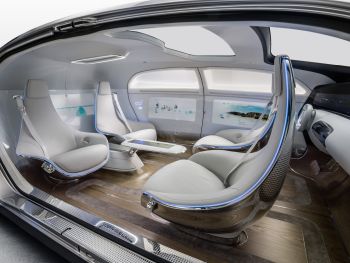
The car has long proved a cornerstone of American life, inextricably tied to almost everything people do in work, life, leisure, and business.
It is also a marker of our contemporary moment, distilling and reacting to cultural cues—think of the bombastic muscle cars of the Vietnam era, and the trepidatious econo-boxes that arrived in its wake. That won’t change anytime soon, but the car will undergo radical change—from the inside out.
“I look at the exterior as the love at first site, and the interior as the long-term relationship,” says says Derek Jenkins, chief of design for California electric vehicle startup Lucid Motors.
“That’s very much where you have to spend time, intimate time, with the vehicle. It’s physical, it’s hands-on. It’s where you really either appreciate the product, or it annoys you.”
New powertrains and new technologies are likely to makeover the automotive interior far more in the next five to ten years than anything seen since Cadillac brought out the first enclosed car in 1910. Cars are learning to drive themselves and starting to talk to each other. They are running on electricity and ditching the family garage.
“Autonomy, connected technologies, electrification, and the share movement. Those four pillars are changing expectation and changing the use case of the interior simultaneously,” Jenkins says.
Some of this rise in the interior’s importance is based on the trickle-down impact of logistics. The average American commute has increased by more than twenty percent since 1980, and globally in mega-cities like Beijing and Cairo, time in the car can stretch out toward the unimaginable. And so people create more requirements of their vehicle.
“The interior of an automobile used to be nothing more than a soft bench seat and a roof to keep occupants comfortable and out of the elements,” says Michael Harley, executive analyst for industry research firm Kelley Blue Book. “Today, it’s a safety cage, a music amphitheater, a telephone conference room, a place to eat meals, and more. Vehicles are no longer machines that simply move people between two points, and shoppers demand much more from the interior than they did even a decade ago.”
Another driver of interior innovation? The vehicle safety and crashworthiness regulations cramp the creativity of exterior designs by necessitating features like smaller windows and blunter front grilles. Combined with the immutability of aerodynamics, you can see why so many cars these days look the same. As exterior design becomes more generic, the interior can shine as a point of differentiation.
The shifting nature of the auto industry will produce more change. Looking for economies of scale, automakers now create “global vehicles”—cars that can be sold in any market around the world. So demands in one region, especially a big markets like China, for things like enhanced rear legroom, mood-enhancing multi-colored ambient lights, and in-car perfume atomizers, find their way across the oceans.
Read more of the original article at Wired.




